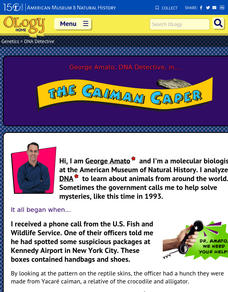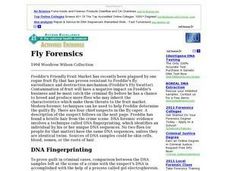University of Colorado
Patterns and Fingerprints
Human fingerprint patterns are the result of layers of skin growing at different paces, thus causing the layers to pull on each other forming ridges. Here, groups of learners see how patterns and fingerprints assist scientists in a...
Curated OER
Fingerprints
This activity provides an interesting way for learners to review vocabulary and practice comprehension skills. There is a six-paragraph passage about the process of fingerprinting and the role it takes on convicting criminals. Eleven...
K20 LEARN
More than Skin Deep
From crime to paternity, DNA fingerprinting has revolutionized how the world views inherited traits. Science sleuths investigate the facts about DNA profiling through a variety of activities. The Teacher's Guide includes printable...
Curated OER
Skin: Skin Prints
Learners explore human anatomy by participating in a print experiment. In this human skin instructional activity, students define the term "epidermis" and utilize computer paper, pencils, tape and baby wipes to create a print of their...
American Museum of Natural History
DNA Detective
Match up the DNA code. Pupils read the website from the American Museum of Natural History about how DNA can determine whether a skin is from a particular type of reptile. Using the same technique, learners match up products with the...
Curated OER
Fly Forensics
Freddy's Friendly Fruit Market is under attack by fruit flies, and it is up to your aspiring biologists to solve the crime! By reading and analyzing the phenotypes, detectives determine which fly is responsible. This memorable assignment...
Curated OER
Whodunit?
Students observe the geometric patterns on fingerprints. They classify fingerprints into groups and obtain prints from surfaces.
Curated OER
DNA Technology
In this DNA technology worksheet, students look at genetic engineering and how it has helped humans. Then students will read about the human genome and how DNA fingerprinting is used in crime scenes. This worksheet has 4 short answer...
American Museum of Natural History
DNA Detective
DNA is like the fingerprint of genetics. A quick lesson introduces the topic of DNA sequences with a mystery about an endangered species. The lesson shows how DNA extraction, replication, and sequencing often provide undeniable evidence...
Curated OER
Human Epidermal Cells
Students explore epidermal cells. After following specified procedures for removing epidermal cells from their wrist, students view the cells with the use of a microscope. After creating a drawing of their observation, students label the...
Curated OER
Elephant Earth Adventures . . .
In this reading comprehension about African elephants activity, students read factual passages about their physical characteristics, amazing facts, tusk uses, ears, trunk, skin, movement, food needs, extended families, and the active...
Curated OER
Museum Practice for Students
Before any of us can learn to enjoy a trip to an art museum, we need to learn how to behave. This list of activities describe the behavior expected on a trip to an art museum. Each behavior comes with an activity intended to demonstrate...
Curated OER
Enzyme and Southern Blotting
Students study southern blotting and its uses. They research on restriction enzymes and their uses, especially in relation to recombinant DNA. In addition, they write a summary and an interpretation of the gel.
Curated OER
Our Healthy Bodies
Students complete a variety of activities designed to enhance their awareness of their bodies. They examine pictures of themselves, taken at various points in the year and examine and compare their bodies. They enjoy a healthy snack...













